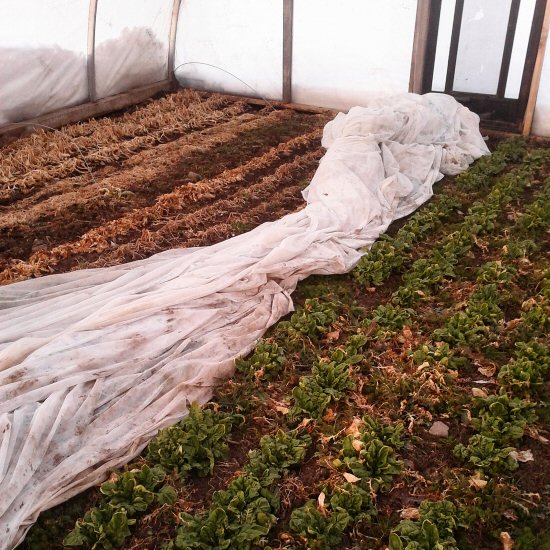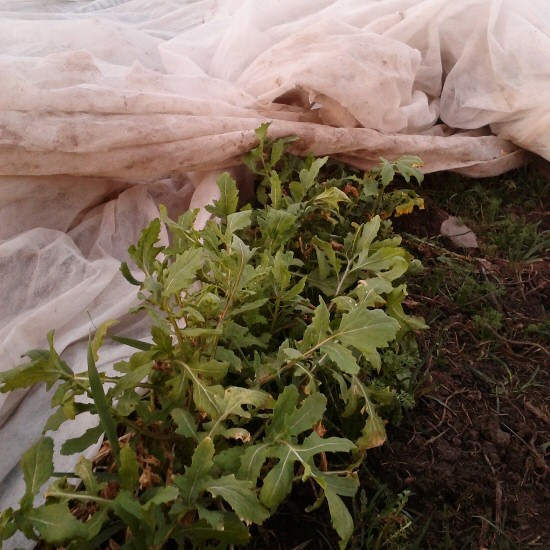
Checking in on the winter greens mini-experiment. These guys have been through six weeks of up and down weather, balmy days well above zero (reaching 60-70°F/15-20°C on a sunny day in the hoophouse) , and many extreme freezing nights. So, how did it all do? The Bloomsdale spinach, uncovered (above), is fine, although after all that freezing and thawing, the taste and texture changes (good to eat, but probably wouldn’t sell). It wasn’t the plan, but this spinach can be trimmed back to see how new growth does in spring. The other beds, all brassicas (tatsoi, mizuna, arugula, mustards), left half uncovered, are completely toasted. Meanwhile, under a single layer of medium-weight row cover, arugula (below) is good, perky and quite tasty. Not the most extensive and scientific testing plan, but combined with the experience of harvesting through December and in mid-January, it’s a solid starting point for next winter’s goal of full-on, unheated winter greens production!





I am working on a student training farm at a university where we have been growing mizuna, spinach, etc. inside solar passive greenhouses and have had great results with using heavier plastic as a row cover instead of light “cloth”. It’s been an exceptionally cold winter as well. Also, we have been diligent about pulling the row covers back when it is warm enough in the hoop, as to not collect too much condensation under the cover (to avoid frost issues when the temps drop) and of course putting them on at the end of the day. bent electrical conduit as braces over the row help hold the heavier plastic up, or you can also use cable wire attached to wood at each row end to suspend it over your crop.
Cool, that sounds like great work! It’d be great to hear more!!
Yes, I’m not sure if this is exactly what you’re referring to, or just avoiding getting the plants too wet in the day, but keeping the condensation on any sort of row cover off the plants is a big deal in early spring transplanting. On frost warning nights you can put floating row cover over early risky plantings in the field, get a light frost, easily save the plants from that with the cover, but then toast the tops that were in contact with the cover where the condensation froze. The wire is a great idea, sounds quick. I usually insert a short stake (12′ or so) every few feet that tent up the cover just enough to clear the seedlings – it only adds a couple minutes per bed and can make a world of difference, and much easier than putting up hoops.
Also from spring planting, not overwintering, but same idea as you’re talking about, we’ll double up medium weight row cover over seedlings at night that are growing and hardening off in the unheated greenhouse. Two layers of floating cover have done wonders when the temperature dipped further below freezing than expected.
It’s interesting that you say plastic did significantly better than fabric, I wonder if part of that has to do with a double greenhouse effect, raising the temperature even more under there during the days if that’s possible, and letting the ground absorb more heat.
Love to hear more about what all you were up to!!! :) Is there a web site?
We are up in Meaford. In the winter we grow spinach under plastic hoop houses – super 6 vapor barrier.
We have experimented with Tyee, Bloomsdale, and Viroflex (giant winter) all from William dam. Bloomsdale definitely does the best overwintering, but it is a fairly thick leaf. Our fav is the Giant Winter – much nicer leaf, but ready about 2 weeks later. Definitely a little less happy about over wintering, but still pretty good.
If we time it right in the fall (we blew it this year) harvest should be doable on April 1 or April 15 for Giant Winter.
There is a huge market (relatively speaking) for early spinach. We were selling it at our local 100 mile store. We have stopped because we are just too small for market gardening. Our total sales were about double our insurance costs. Just not worth it. Sample it and it will move.
Nice farming blog.